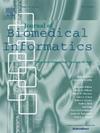Evaluating the Bias, type I error and statistical power of the prior Knowledge-Guided integrated likelihood estimation (PIE) for bias reduction in EHR based association studies
IF 4
2区 医学
Q2 COMPUTER SCIENCE, INTERDISCIPLINARY APPLICATIONS
引用次数: 0
Abstract
Objectives
Binary outcomes in electronic health records (EHR) derived using automated phenotype algorithms may suffer from phenotyping error, resulting in bias in association estimation. Huang et al. [1] proposed the Prior Knowledge-Guided Integrated Likelihood Estimation (PIE) method to mitigate the estimation bias, however, their investigation focused on point estimation without statistical inference, and the evaluation of PIE therein using simulation was a proof-of-concept with only a limited scope of scenarios. This study aims to comprehensively assess PIE’s performance including (1) how well PIE performs under a wide spectrum of operating characteristics of phenotyping algorithms under real-world scenarios (e. g., low prevalence, low sensitivity, high specificity); (2) beyond point estimation, how much variation of the PIE estimator was introduced by the prior distribution; and (3) from a hypothesis testing point of view, if PIE improves type I error and statistical power relative to the naïve method (i.e., ignoring the phenotyping error).
Methods
Synthetic data and use-case analysis were utilized to evaluate PIE. The synthetic data were generated under diverse outcome prevalence, phenotyping algorithm sensitivity, and association effect sizes. Simulation studies compared PIE under different prior distributions with the naïve method, assessing bias, variance, type I error, and power. Use-case analysis compared the performance of PIE and the naïve method in estimating the association of multiple predictors with COVID-19 infection.
Results
PIE exhibited reduced bias compared to the naïve method across varied simulation settings, with comparable type I error and power. As the effect size became larger, the bias reduced by PIE was larger. PIE has superior performance when prior distributions aligned closely with true phenotyping algorithm characteristics. Impact of prior quality was minor for low-prevalence outcomes but large for common outcomes. In use-case analysis, PIE maintains a relatively accurate estimation across different scenarios, particularly outperforming the naïve approach under large effect sizes.
Conclusion
PIE effectively mitigates estimation bias in a wide spectrum of real-world settings, particularly with accurate prior information. Its main benefit lies in bias reduction rather than hypothesis testing. The impact of the prior is small for low-prevalence outcomes.

评估基于电子病历的关联研究中先验知识引导的综合似然估计(PIE)的偏倚、I型误差和统计能力
目的:使用自动表型算法得出的电子健康记录(EHR)的二元结果可能存在表型误差,导致关联估计偏差。Huang等人([1])提出了先验知识引导的综合似然估计(PIE)方法来减轻估计偏差,但他们的研究主要集中在没有统计推断的点估计上,其中使用模拟评估PIE是一种概念验证,只有有限的场景范围。本研究旨在全面评估PIE的性能,包括(1)在现实场景下,PIE在表型算法的广泛操作特征下表现如何(例如 g)。(低患病率、低敏感性、高特异性);(2)超越点估计,先验分布引入了多少PIE估计量的变化;(3)从假设检验的角度来看,如果PIE相对于naïve方法(即忽略表型误差)改善了I型误差和统计能力。方法:利用费城儿童医院的综合数据和实际电子病历数据对PIE进行评估。合成数据是根据不同的结果患病率、表型算法敏感性和关联效应大小生成的。模拟研究用naïve方法比较了不同先验分布下的PIE,评估了偏差、方差、I型误差和功率。现实世界分析比较了PIE和naïve方法在估计多个预测因素与COVID-19感染的相关性方面的表现。结果:与naïve方法相比,PIE在不同的模拟设置中表现出较小的偏差,具有可比的I型误差和功率。效应量越大,PIE减小的偏倚越大。当先验分布与真实表型算法特征紧密一致时,PIE具有优越的性能。先前质量对低流行结局的影响较小,但对常见结局的影响较大。在现实世界的分析中,PIE在不同的场景中保持了相对准确的估计,特别是在大效应量下优于naïve方法。结论:PIE有效地减轻了在广泛的现实世界环境中的估计偏差,特别是在准确的先验信息下。它的主要好处在于减少偏见,而不是假设检验。对于低流行率的结果,先前的影响很小。
本文章由计算机程序翻译,如有差异,请以英文原文为准。
求助全文
约1分钟内获得全文
求助全文
来源期刊

Journal of Biomedical Informatics
医学-计算机:跨学科应用
CiteScore
8.90
自引率
6.70%
发文量
243
审稿时长
32 days
期刊介绍:
The Journal of Biomedical Informatics reflects a commitment to high-quality original research papers, reviews, and commentaries in the area of biomedical informatics methodology. Although we publish articles motivated by applications in the biomedical sciences (for example, clinical medicine, health care, population health, and translational bioinformatics), the journal emphasizes reports of new methodologies and techniques that have general applicability and that form the basis for the evolving science of biomedical informatics. Articles on medical devices; evaluations of implemented systems (including clinical trials of information technologies); or papers that provide insight into a biological process, a specific disease, or treatment options would generally be more suitable for publication in other venues. Papers on applications of signal processing and image analysis are often more suitable for biomedical engineering journals or other informatics journals, although we do publish papers that emphasize the information management and knowledge representation/modeling issues that arise in the storage and use of biological signals and images. System descriptions are welcome if they illustrate and substantiate the underlying methodology that is the principal focus of the report and an effort is made to address the generalizability and/or range of application of that methodology. Note also that, given the international nature of JBI, papers that deal with specific languages other than English, or with country-specific health systems or approaches, are acceptable for JBI only if they offer generalizable lessons that are relevant to the broad JBI readership, regardless of their country, language, culture, or health system.
 求助内容:
求助内容: 应助结果提醒方式:
应助结果提醒方式:


